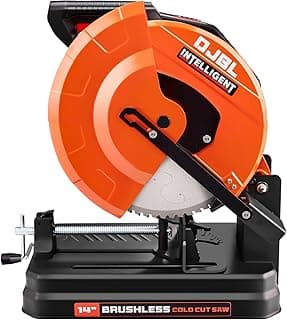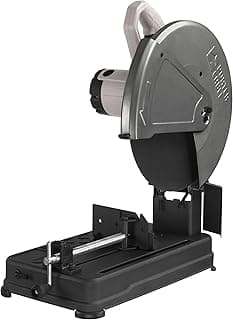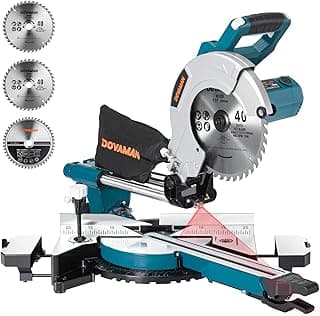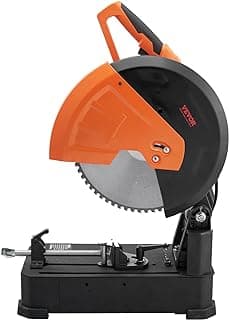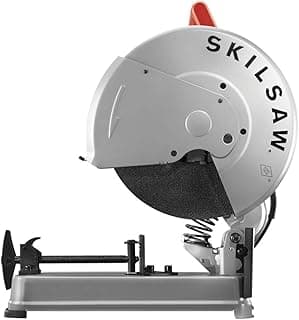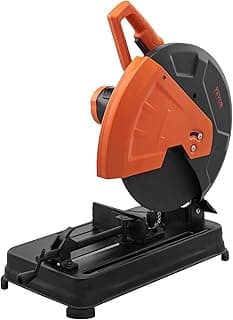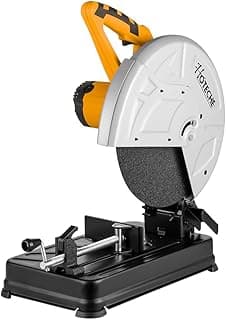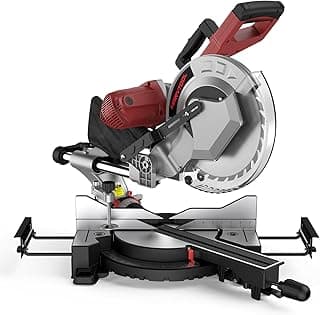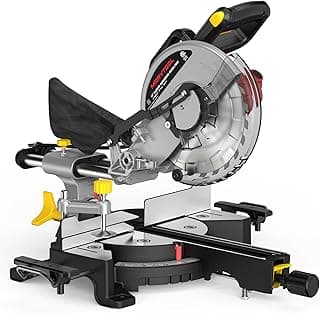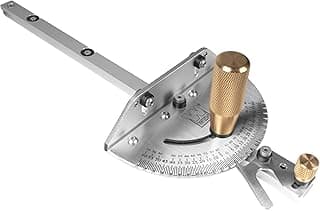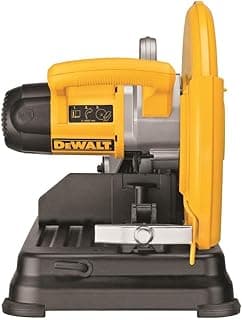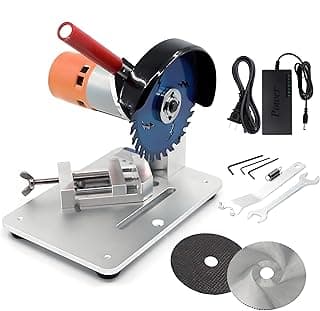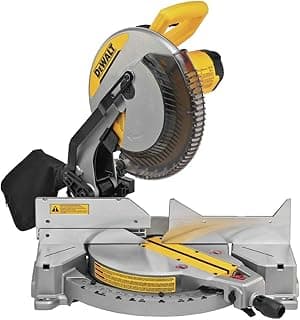When working with steel reinforcement bars, precision and cutting efficiency matter. That’s why choosing the best chop saws for cutting rebar can make all the difference between a smooth workflow and wasted time. But wait—what if you also handle wood or other materials? In that case, you might explore related options like the best chop saws for wood or even the best chop saw blade for wood to expand versatility in your workshop. Still unsure which model fits your needs? Keep reading, because we’ll break down the key features, performance insights, and expert tips to help you pick the best chop saw for your next project.
Top Picks
Best Ergonomic Design: DEWALT Chop Saw, 14-Inch (D28730)
The DEWALT Metal Chop Saw stands out for its powerful 2300W motor, built to handle heavy-duty cutting without overheating or slowing down. Its consistent power output makes it suitable for cutting through tough metals efficiently, reducing downtime and improving workflow in demanding job sites. The ergonomically designed handle enhances comfort during extended use, minimizing hand fatigue and allowing for greater control, especially when handling larger materials.
The Quick-Lock vise is another practical feature, enabling users to clamp and release materials quickly, which saves time when switching between different workpieces. The 45-degree pivoting fence supports precise miter cuts, making it versatile for various metal fabrication tasks. While the corded design limits mobility, most users appreciate the reliability and continuous power supply it provides.
From a customer perspective, this model earns praise for its solid construction, ease of use, and accuracy in repetitive cuts. Many users highlight its durability and comfortable handling as key reasons for choosing DEWALT over other brands. However, a few note that its weight and lack of portability make it less ideal for those frequently moving between job sites. Overall, it’s viewed as a dependable, high-performance tool for professionals who prioritize precision and comfort in metal cutting.
Best Dry-Cut Performance: Evolution S355CPSL – Heavy Duty 14 Inch Metal Cutting Chop Saw
The EVOLUTION S355CPSL Metal Cutting Saw delivers impressive cutting performance through its powerful 15 Amp motor and dry-cut technology. Unlike traditional abrasive saws, it generates minimal heat and virtually no sparks, producing clean, burr-free edges that require little to no finishing. This feature makes it ideal for professionals seeking efficiency and precision in metal fabrication or construction work.
Its cast steel vise and adjustable fence enable smooth, accurate miter cuts up to 45 degrees, offering flexibility for angled or custom cuts. The quick-release mechanism simplifies workpiece changes, boosting workflow speed without compromising safety or accuracy. The pressed steel base contributes to stability while keeping the tool lightweight enough for easy transport between job sites.
Users frequently praise the saw for its consistent cutting quality and the long-lasting tungsten carbide-tipped blade, which remains sharp even after extended use. Many also appreciate the built-in chip deflector that keeps debris away, making cleanup faster and safer. However, some note that the saw can be relatively loud during operation, a trade-off for its power and cutting speed. Overall, this model stands out for combining industrial-grade precision with user-friendly design and dependable performance.
Best Smart Power Control: DJBL 14" 3500w Brushless Cold Cut Saw,Dry Cut Saw Cutting Speeds Changeable
The DJBL Metal Cutting Saw sets itself apart with its advanced 3500W brushless motor, delivering exceptional torque and long-term durability. The closed aluminum motor housing keeps the system cool and protected, ensuring consistent performance even under demanding workloads. Despite its power, the saw maintains a relatively low noise level, offering a smoother and quieter working experience compared to many competitors.
Its intelligent motor driver is a standout feature, incorporating a soft-start delay for safer activation and a rapid-stop function for better control. The three adjustable speed settings allow users to fine-tune performance based on the material and thickness, maintaining precision while cutting. Combined with the ferrous metal cermet blade, this saw produces clean, burr-free cuts with minimal sparks—ideal for professionals requiring efficiency and accuracy.
The adjustable 0–45° fence simplifies angled cuts, while the sturdy aluminum alloy base provides stability and chip collection for a cleaner workspace. Users commend its precision, versatility, and smooth operation across various metals such as steel, aluminum, and angle iron. Some note that its weight may affect portability, but most agree that its advanced motor control and cutting consistency make it an outstanding tool for heavy-duty applications in workshops and construction environments.
FAQs
Can I Cut Rebar with a Chop Saw?
Yes, you can cut rebar with a chop saw—provided it’s equipped with the right type of abrasive or carbide-tipped metal-cutting blade. A chop saw offers the high torque and rotational speed necessary to slice through steel quickly and cleanly. However, it’s crucial to avoid using wood-cutting blades, as they lack the hardness and durability to handle metal. Always secure the rebar firmly in a vise or clamp before cutting to prevent movement and ensure safety.
What Kind of Saw Do You Use to Cut Rebar?
The most effective tools for cutting rebar are abrasive chop saws and metal-cutting band saws. Abrasive chop saws are the go-to option for professionals because they use high-speed rotating discs designed specifically for ferrous metals. Alternatively, a portable rebar cutter can also do the job with minimal sparks and noise. While an angle grinder is suitable for small or quick cuts, it’s less precise and more fatiguing for large volumes. For repetitive, accurate cuts, a stationary metal chop saw is the best choice.
How Best to Cut Rebar?
To achieve clean, safe cuts, follow these best practices:
-
Choose the right blade. Use an abrasive disc or carbide-tipped blade rated for metal.
-
Secure the rebar. Clamp it tightly in the saw’s vise to prevent kickback.
-
Mark your cut line. Use chalk or a permanent marker for accuracy.
-
Let the saw do the work. Avoid forcing the blade through; steady pressure ensures even cuts.
-
Cool the blade. Allow rest periods between cuts to prevent overheating and extend blade life.
If you need perfectly consistent lengths for framing or fabrication, set up a cutting jig or stop block to improve efficiency.
How Many TPI for Cutting Rebar?
TPI (teeth per inch) determines how smooth and efficient your cut will be. For cutting rebar, you need a low TPI blade—typically between 8 and 14 TPI—to handle thicker metal without clogging. Fewer teeth mean deeper gullets that remove metal chips more efficiently, preventing overheating and blade wear. Blades with higher TPI counts are better suited for thin materials like sheet metal, not for dense, solid bars like rebar.
Final Thoughts
Cutting rebar requires more than brute force—it demands precision, stability, and the right tool. The best chop saws for cutting rebar combine high torque, durable blades, and sturdy build quality to ensure clean, repeatable results on every project. Whether you’re reinforcing concrete, fabricating steel structures, or tackling home improvements, investing in the proper saw will save time, improve accuracy, and keep your worksite safe and efficient.



